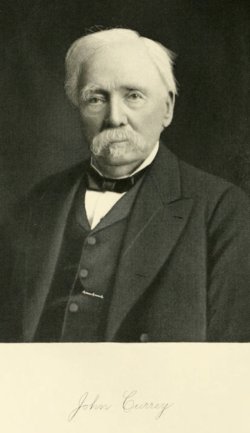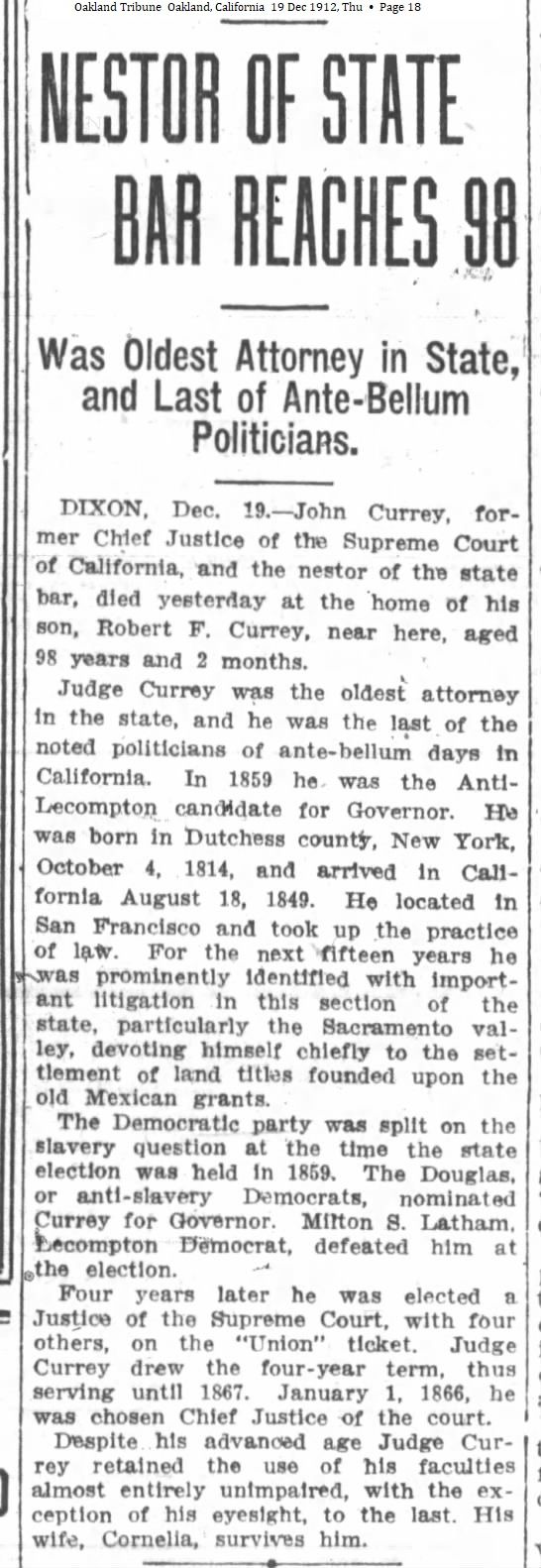Rebecca Ward, New York,
b. Feb 3, 1776
d. Aug 31,1864; m. abt. 1796,
Thomas Lambert Currey, Peekskill, N. Y.
b. Sept 23, 1773; d. Oct 7, 1862.
Attorney, Eighth Chief Justice of the California Supreme Court (1866-1868);Associate Justice (1864-1866);specialist in Mexican Land Grant Claims; Pioneer of 1849; Candidate for Governor of California in 1859.
John Moore Currey, (1814-1912), L.L.D. - Williams College of Massachusetts-1870
One of the first lawyers of the new state, he served as one of three commissioners charged with revising and compiling the laws of the State; His private practice dealt with the law related to land claims, particularly rulings on Mexican land grants and land rights. Among his most famous clients were Juan Manuel Vaca and Juan Felipe Pena.
One of twins (James) of Thomas and Rebecca (Ward) Currey, he was born in Cortlandtown, Westchester co., New York.
He married twice: first (1845) to Cornelia Elizabeth Scott (1818-1877), second (1881) to Cornelia Nelson Ferris (1845-1921).
Growing up on a farm, his education began at the local 'District' school and later at Peekskill Military Academy, Peekskill, NY.(age 16), Amenia Seminary at Amenia, N.Y., the West Poultney Academy at West Poultney, Vt. for some time. By 1839, his law training began, in the practice of Hon. William Nelson (Peekskill, New York). He attended Wesleyan University, Middleton, NY.
By 1842 he had become an attorney before the Supreme Court of New York State, as well as a solicitor in chancery. He then joined the law office Edward Wells (Peekskill, NY) where he remained for five years. After which he joined the practice of Theordore R. Westbrook at Kingston, Ulster co., New York, remaining until about 1847.
In 1849, Currey left for a six-month trip to California to investigate life in the gold fields. Sailing for California from New York in 1849, he walked across the Isthmus of Panama [no canal at the time] and arrived at San Francisco, August 18, 1849. Quickly discovering that mining did not suit him, he started a law practice in San Francisco. 18 months later, having established himself in the new state, he returned to Peekskill, NY, for his wife and son. Returning to SF, they found the SF law office had been destroyed by fire. Moving to Benecia to live, his practice there concentrated on on Spanish and Mexican land grant litigation. With the resolution of Vaca & Pena's appeal, he received some of his compensation in land, notably on Putah Creek near Dixon, California. Benecia was the first waterside Anglo-American city, and the new state capital for thirteen months (1853-1854).
In 1859, against his will, he was put forward as a gubernatorial candidate by the Union party. The party, composed of Whigs and Democrats led by Senator Broderick, was opposed to the extension of slavery. However, pro-slavery sentiments of the state prevailed in the election. The party's founder, Senator Broderick was killed in a duel that capped the furious and rancorous campaign. Years later, after passions had cooled, Judge Currey wrote a history of the duel.
The Curreys moved to Sacramento in 1860.
In 1862 the Union Party (of California) was formed by the amalgamation of the anti-slavery Democrats and Republicans.
By 1863, the 1849 State Constitution had been ammended to increase the number of Judges' seats on the California Supreme Court was increased from three to five. In 1864, Currey was elected Justice of the Supreme Court of the State and Chief Justice of the Supreme Court of the State 1866-1868.
He received the honorary degree of L.L.D. from Williams College of Massachusetts in 1870.
Cornelia Elizabeth Scott Currey, his first wife, died in 1877.
Retiring from active law practice, in 1880, he started to spend more of his time at the ranch near Dixon. In 1881 momentarily returning to Peekskill, New York, he married a second time to Cornelia Nelson Ferris, the daughter and granddaughter of two of his old mentors. (J. Henry Ferris, and Judge William Nelson). She was 30 years his junior.
The 1906 earthquake and fire destroyed the Palace Hotel, his San Francisco residence. He escaped, but he lost all his possessions.
Through out his life he was actively involved in many personal interests and connections with the world outside himself. Through out his life, he remained interested in the business and professional world of San Francisco. Always keeping an official residence in the City, he enjoyed a wide circle of friends and belonged to a number of institutions: The Academy of Sciences, the Geographical Society, the Society of Pioneers, the American Bar Association, and the California Bar Association.
Judge Currey continued writing about law until his failing eyesight compelled him to retire completely when colleagues could no longer read his handwriting.
Judge Currey died December 18, 1912 (age 98)on his ranch at Dixon, California.
``````````````````````````````````````````````````````
Spouses:
Cornelia Elizabeth Scott Currey (1818-1877)
Cornelia Mandeville Ferris Currey (1843-1921)
Children:
Montgomery Scott Currey (1846-1898), m. Sept., 1882, Louise Fredericka Alexander (1851-1912)
Robert John Currey (1851-1923), m. Lillie May Buckabee (1854-1935)
Jane Curry (1850- )
Julia Augusta Currey (1853-1885)
Charles Currey (1855-1861) died age 5.
Rebecca Ward, New York,
b. Feb 3, 1776
d. Aug 31,1864; m. abt. 1796,
Thomas Lambert Currey, Peekskill, N. Y.
b. Sept 23, 1773; d. Oct 7, 1862.
Attorney, Eighth Chief Justice of the California Supreme Court (1866-1868);Associate Justice (1864-1866);specialist in Mexican Land Grant Claims; Pioneer of 1849; Candidate for Governor of California in 1859.
John Moore Currey, (1814-1912), L.L.D. - Williams College of Massachusetts-1870
One of the first lawyers of the new state, he served as one of three commissioners charged with revising and compiling the laws of the State; His private practice dealt with the law related to land claims, particularly rulings on Mexican land grants and land rights. Among his most famous clients were Juan Manuel Vaca and Juan Felipe Pena.
One of twins (James) of Thomas and Rebecca (Ward) Currey, he was born in Cortlandtown, Westchester co., New York.
He married twice: first (1845) to Cornelia Elizabeth Scott (1818-1877), second (1881) to Cornelia Nelson Ferris (1845-1921).
Growing up on a farm, his education began at the local 'District' school and later at Peekskill Military Academy, Peekskill, NY.(age 16), Amenia Seminary at Amenia, N.Y., the West Poultney Academy at West Poultney, Vt. for some time. By 1839, his law training began, in the practice of Hon. William Nelson (Peekskill, New York). He attended Wesleyan University, Middleton, NY.
By 1842 he had become an attorney before the Supreme Court of New York State, as well as a solicitor in chancery. He then joined the law office Edward Wells (Peekskill, NY) where he remained for five years. After which he joined the practice of Theordore R. Westbrook at Kingston, Ulster co., New York, remaining until about 1847.
In 1849, Currey left for a six-month trip to California to investigate life in the gold fields. Sailing for California from New York in 1849, he walked across the Isthmus of Panama [no canal at the time] and arrived at San Francisco, August 18, 1849. Quickly discovering that mining did not suit him, he started a law practice in San Francisco. 18 months later, having established himself in the new state, he returned to Peekskill, NY, for his wife and son. Returning to SF, they found the SF law office had been destroyed by fire. Moving to Benecia to live, his practice there concentrated on on Spanish and Mexican land grant litigation. With the resolution of Vaca & Pena's appeal, he received some of his compensation in land, notably on Putah Creek near Dixon, California. Benecia was the first waterside Anglo-American city, and the new state capital for thirteen months (1853-1854).
In 1859, against his will, he was put forward as a gubernatorial candidate by the Union party. The party, composed of Whigs and Democrats led by Senator Broderick, was opposed to the extension of slavery. However, pro-slavery sentiments of the state prevailed in the election. The party's founder, Senator Broderick was killed in a duel that capped the furious and rancorous campaign. Years later, after passions had cooled, Judge Currey wrote a history of the duel.
The Curreys moved to Sacramento in 1860.
In 1862 the Union Party (of California) was formed by the amalgamation of the anti-slavery Democrats and Republicans.
By 1863, the 1849 State Constitution had been ammended to increase the number of Judges' seats on the California Supreme Court was increased from three to five. In 1864, Currey was elected Justice of the Supreme Court of the State and Chief Justice of the Supreme Court of the State 1866-1868.
He received the honorary degree of L.L.D. from Williams College of Massachusetts in 1870.
Cornelia Elizabeth Scott Currey, his first wife, died in 1877.
Retiring from active law practice, in 1880, he started to spend more of his time at the ranch near Dixon. In 1881 momentarily returning to Peekskill, New York, he married a second time to Cornelia Nelson Ferris, the daughter and granddaughter of two of his old mentors. (J. Henry Ferris, and Judge William Nelson). She was 30 years his junior.
The 1906 earthquake and fire destroyed the Palace Hotel, his San Francisco residence. He escaped, but he lost all his possessions.
Through out his life he was actively involved in many personal interests and connections with the world outside himself. Through out his life, he remained interested in the business and professional world of San Francisco. Always keeping an official residence in the City, he enjoyed a wide circle of friends and belonged to a number of institutions: The Academy of Sciences, the Geographical Society, the Society of Pioneers, the American Bar Association, and the California Bar Association.
Judge Currey continued writing about law until his failing eyesight compelled him to retire completely when colleagues could no longer read his handwriting.
Judge Currey died December 18, 1912 (age 98)on his ranch at Dixon, California.
``````````````````````````````````````````````````````
Spouses:
Cornelia Elizabeth Scott Currey (1818-1877)
Cornelia Mandeville Ferris Currey (1843-1921)
Children:
Montgomery Scott Currey (1846-1898), m. Sept., 1882, Louise Fredericka Alexander (1851-1912)
Robert John Currey (1851-1923), m. Lillie May Buckabee (1854-1935)
Jane Curry (1850- )
Julia Augusta Currey (1853-1885)
Charles Currey (1855-1861) died age 5.
Family Members
Sponsored by Ancestry
Advertisement
Advertisement





















